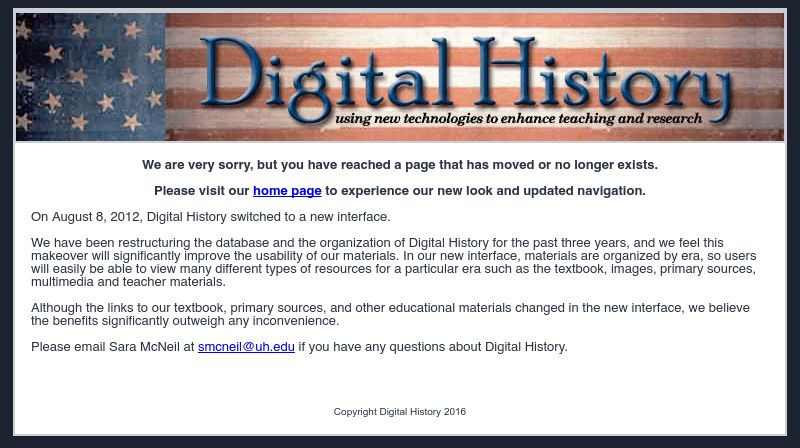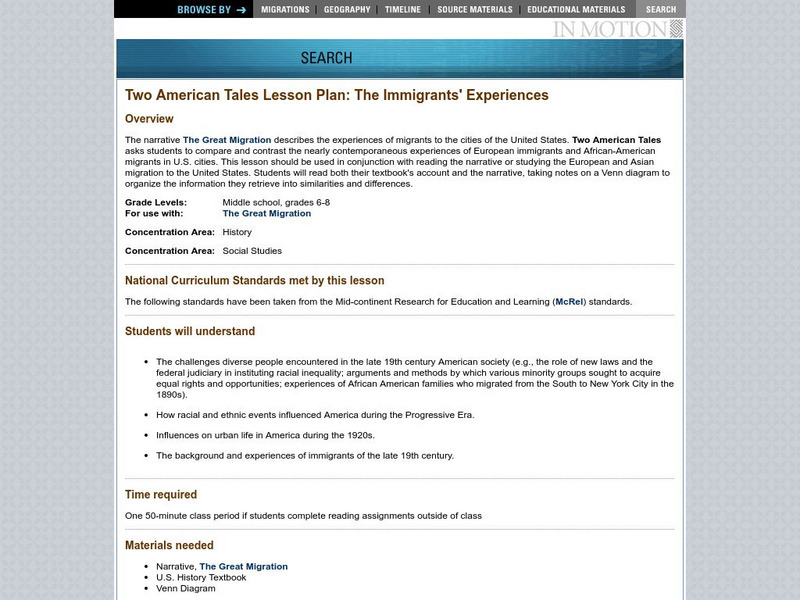Sophia Learning
Sophia: Urban Models in the Real World
By using Google Earth and city road maps, students will compare the layout of their city to one of the three North American urban models and see which one is the best fit.
OpenStax
Open Stax: Urbanization 1870 1900: Great Migration and New European Immigration
What caused the influx of African Americans and European immigrants into urban centers in the late 19th century? Learn about some of the discriminatory and anti-immigrant laws that were enacted to restrict their rights. Includes a chart...
PBS
Pbs: "Kill the Indian and Save the Man": Native American Representation
Learn about the impact of US government policies of assimilation, relocation, and urbanization on Native American identity and culture in this series of videos from the American Masters film Words from a Bear: N. Scott Momaday. Years...
The Newberry Library
Newberry Library: The Struggle for Civil Rights in the Urban North
Learning resource using primary sources in which students study de facto segregation in the North following the Civil War and examine how African-Americans responded to segregation and racism compared to the South.
Library of Congress
Loc: African American Perspectives: Ida B. Wells
Read about the efforts of Ida B. Wells to combat lynchings of African Americans that were still occurring mainly in the South during the first part of the 20th century.
University of Groningen
American History: Outlines: Industrial Growth
By 1860, when Abraham Lincoln was elected president, 16 percent of the population lived in urban areas and a third of the nation's income came from manufacturing. Funds were flowing into large-scale industrial development and into...
Khan Academy
Khan Academy: Ap Us History: Native American Culture of the Southeast
The dominant Mississippian culture of the Southeast signaled agricultural success and urban development for a variety of Native American groups.
Bowling Green State University
United States History: Industrialization, Urbanization, and Immigration
These are study notes for key points when learning about the industrialization of America during the Gilded Age. Looks at causes and consequences of the First and Second Industrial Revolutions, the impact of rapid urbanization, and the...
Other
Dept. Of Housing and Urban Dev. (Hud): Native Americans
A resource page for Native Americans in reference to land and/or homebuyers. Site is sponsored by the Department of Housing and Urban Development.
Polk Brothers Foundation Center for Urban Education at DePaul University
De Paul University: Center for Urban Education: Lexington [Pdf]
"Lexington" is a one page, historical fiction, reading passage about soldiers fighting in the Revolutionary War. A soldier describes the feeling of being an American. It is followed by constructed-response questions which require...
Polk Brothers Foundation Center for Urban Education at DePaul University
Depaul University: Center for Urban Education: Native Americans: Potawatomi[pdf]
"Native American Life--Potawatomi Profile" is a one page, non-fiction, first person reading/thinking passage about the Potawatomi Native American tribe. It includes information about what they did during each of the seasons of the year.
Rock and Roll Hall of Fame
Rock & Roll Hall of Fame: Sti Lesson 15: The Changing American Landscape
The rise of American cities between 1865 and 1900 was spawned by the industrial revolution. Technological advancements in industry and transportation fathered the enormous growth of large cities across the United States. This led to the...
Polk Brothers Foundation Center for Urban Education at DePaul University
De Paul University: Center for Urban Education: Before Chicago [Pdf]
"Before Chicago" is a one page, non-fiction, reading passage about Native Americans who lived in what is now Chicago. It describes what life was like for them and tells how Chicago got its name. It is followed by constructed-response...
Polk Brothers Foundation Center for Urban Education at DePaul University
De Paul University: Center for Urban Education: Gwendolyn Brooks, Poet [Pdf]
"Gwendolyn Brooks, Poet" is a one page, biographical passage about Gwendolyn Brooks, an African-American poet from Chicago. It is followed by an open-ended question which requires students to provide evidence from the story; it includes...
Polk Brothers Foundation Center for Urban Education at DePaul University
De Paul University: Center for Urban Education: George Washington Carver [Pdf]
"George Washington Carver" is a one page, biographical passage about George Washington Carver, an African American professor who taught farmers and students better methods for farming, including planting peanuts to improve the soil. It...
Polk Brothers Foundation Center for Urban Education at DePaul University
De Paul University: Center for Urban Education: George Washington Carver [Pdf]
"George Washington Carver" is a one page, biographical passage about George Washington Carver, a famous African American, who taught farmers better farming methods including planting peanuts to improve the soil. It is followed by an...
Library of Congress
Loc: African American Mosaic: Chicago: Destination for the Great Migration
Discusses the housing arrangements of African Americans and those with incomes in the Chicago area. Includes several pictures and links to further related information.
National Humanities Center
National Humanities Center: Toolbox Library: Associations (I), Making of African American Identity: V. 2
Newspaper articles that illustrate how benevolent and charitable societies fostered racial solidarity among African Americans in late-nineteenth-century America are provided. Links to these articles can be found on the second page.
Digital History
Digital History: The Birth of American Popular Culture
American popular culture was many-faceted prior to the Civil War. Find out about the explosion of the number of newspapers and magazines, the many kinds of popular entertainment, and even phrenology as entertainment.
Other
National Urban League Home Page
The homepage of the National Urban League, whose mission "is to enable African Americans to secure economic self-reliance, parity and power and civil rights."
PBS
Pbs Learning Media: Black Urban Poor, William Julius Wilson
In this 1998 FRONTLINE interview, Harvard sociologist Dr. William Julius Wilson explains why, despite an overall increase in the standard of living among African Americans, a segment of the population is falling farther and farther behind.
American Presidency Project
American Presidency Project: Veto of the Second Housing and Urban Renewal Bill
Read the text of President Eisenhower's letter to the Senate in which he lays out his reasons for vetoing a housing bill. See the specifics he gives that he feels would improve the bill and allow him to sign it.
University of Richmond
Digital Scholarship Lab: American Panorama: Renewing Inequality
For a quarter-century, the federal government provided funding for cities large and small to raze "blighted" or "slum" neighborhoods. Through these programs, cities displaced hundreds of thousands of families from their homes and...
New York Public Library
The Great Migration: Two American Tales Lesson Plan: The Immigrants' Experiences
Part of an online exhibit that describes the experiences of migrants to the cities of the United States. Two American Tales asks students to compare and contrast the nearly contemporaneous experiences of European immigrants and...















